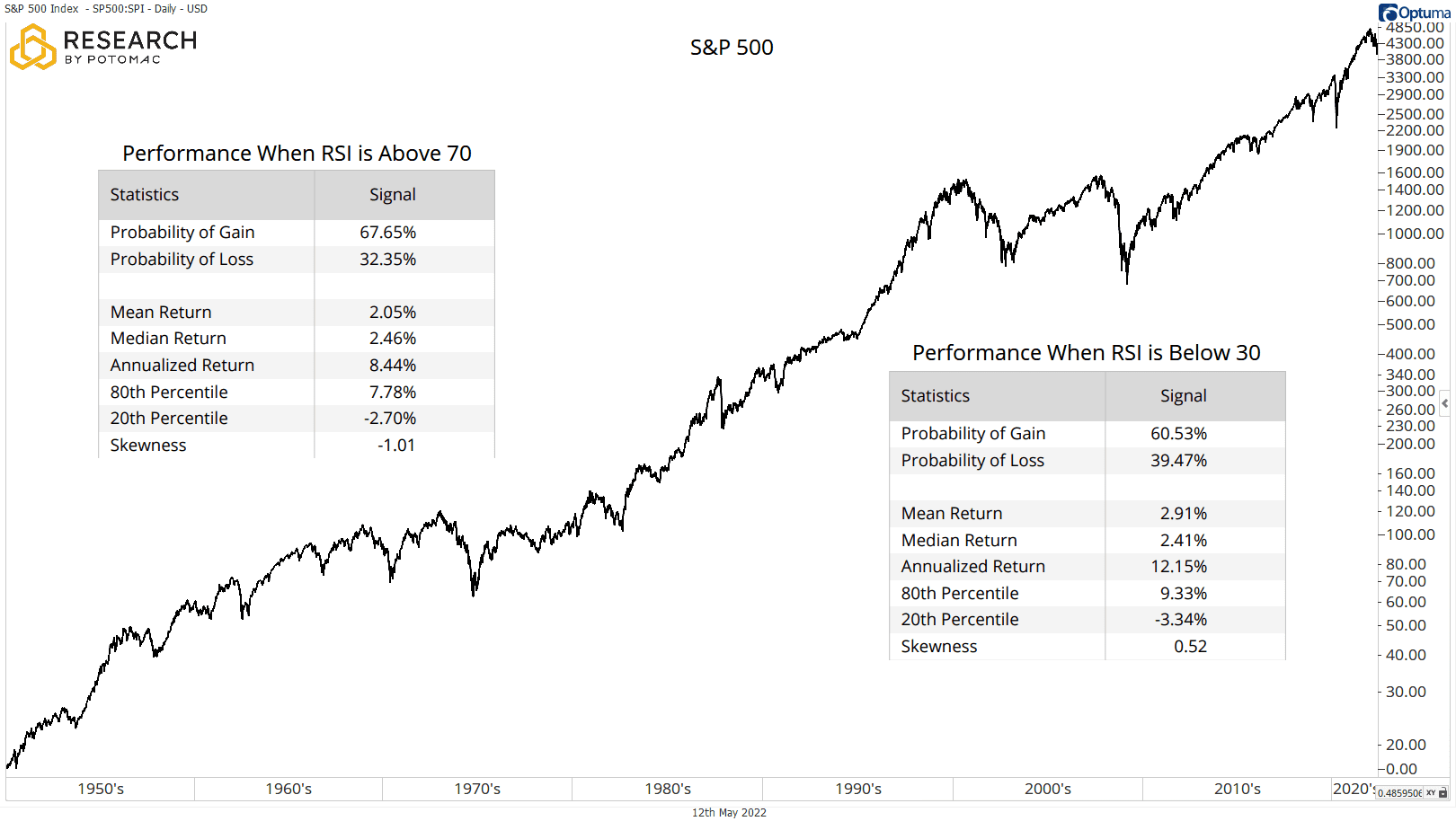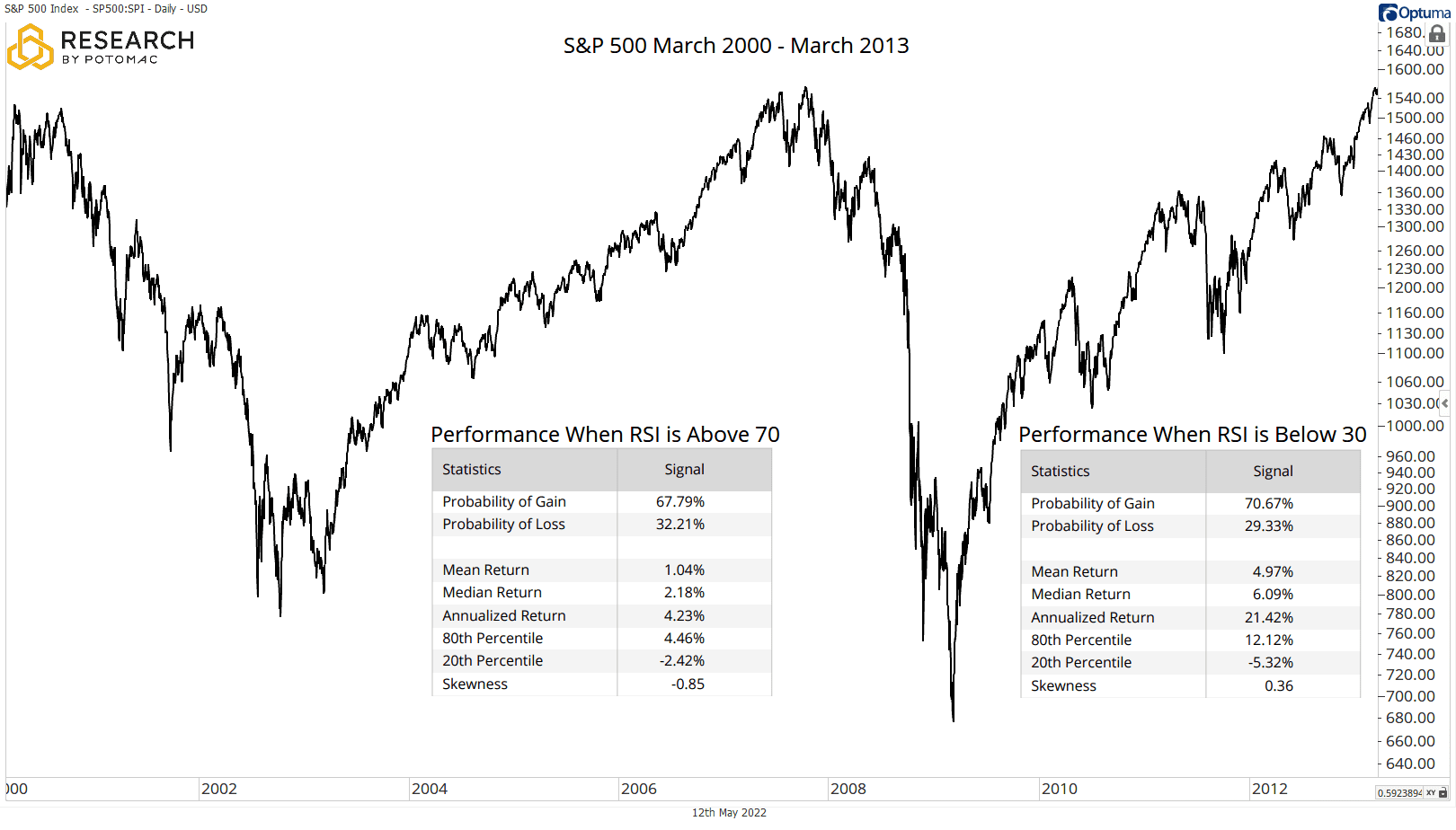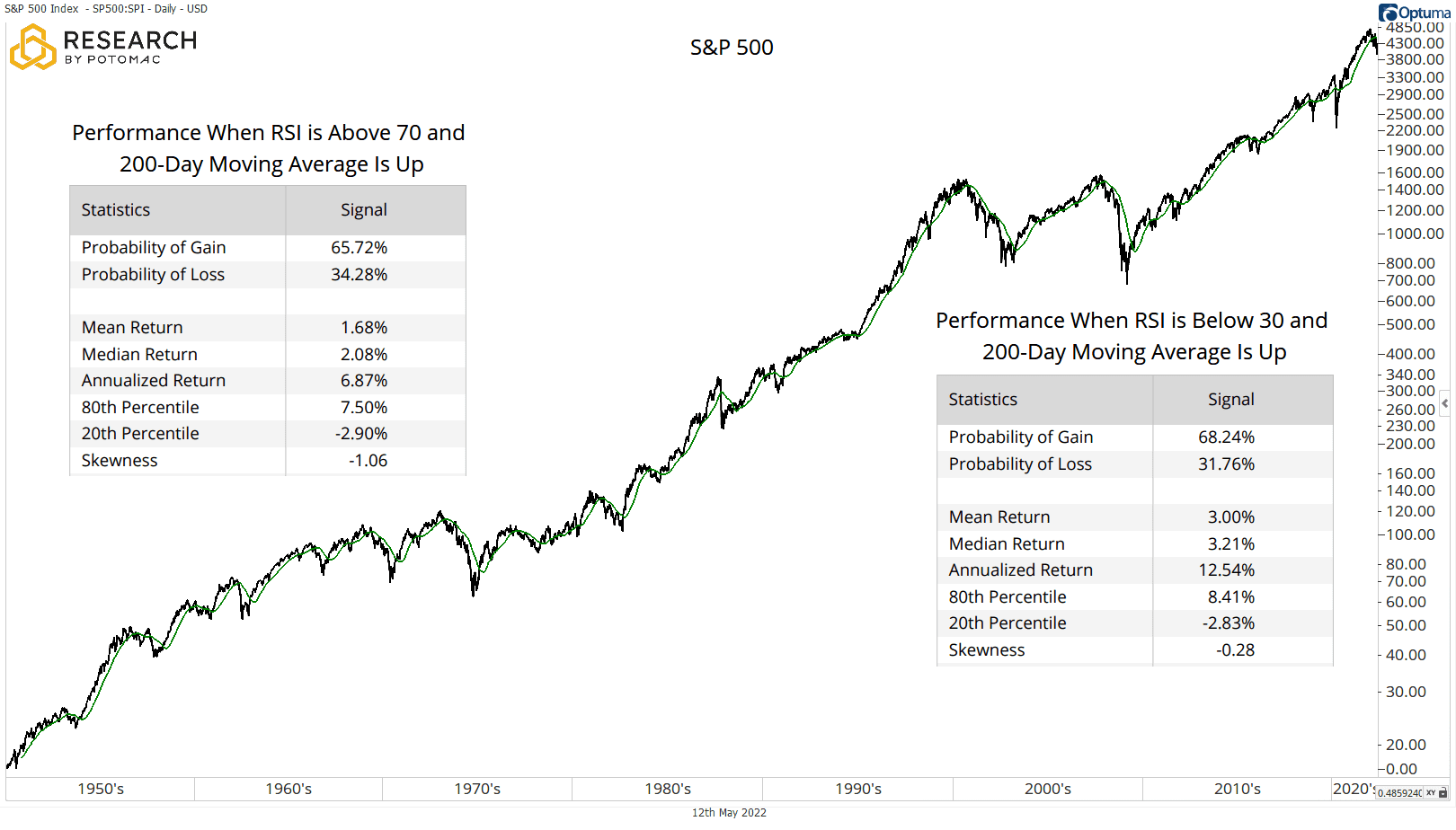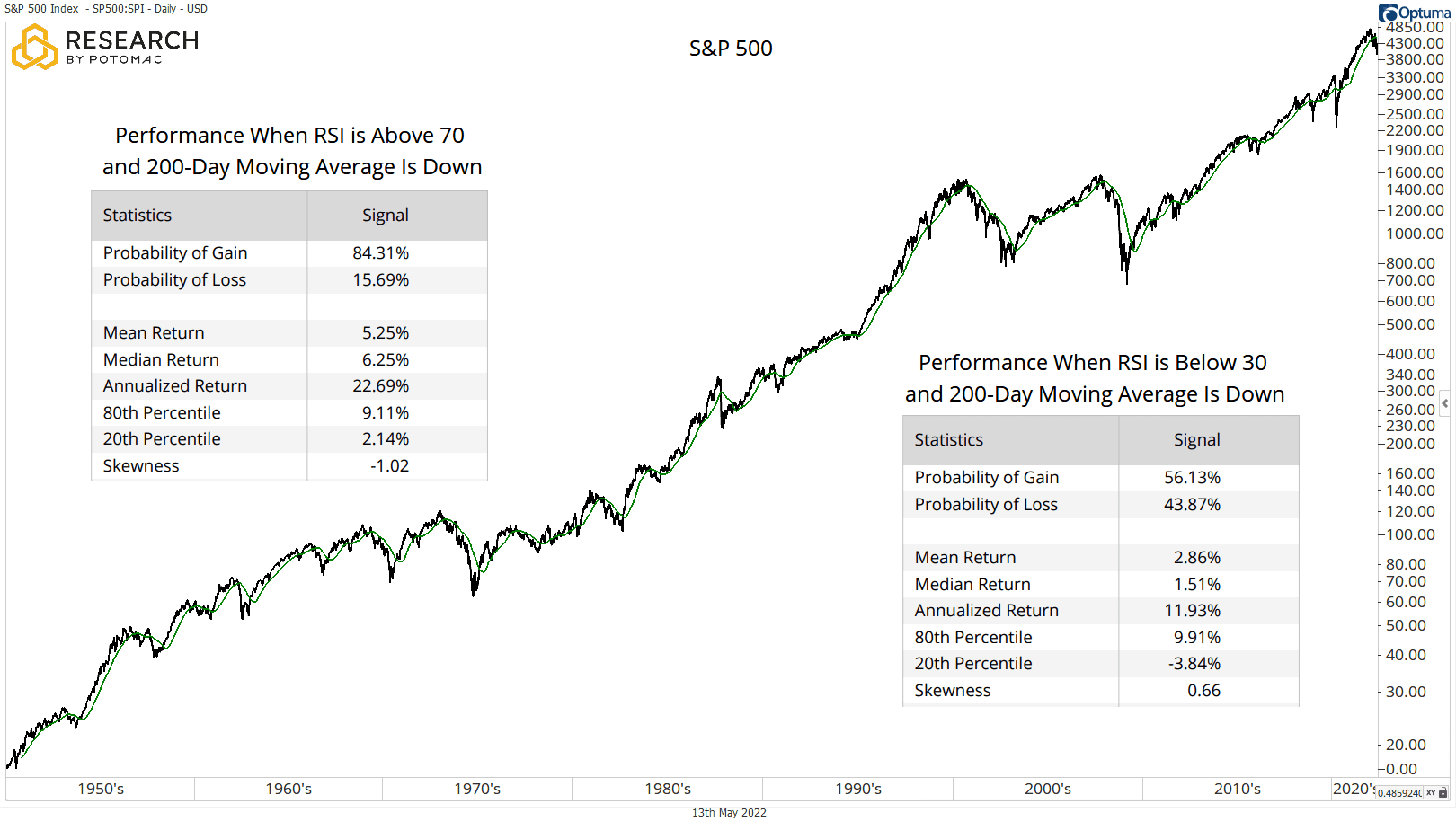
The Relative Strength Index, or RSI, has been a staple in many market analysts’ toolboxes for decades. The RSI is one of (if not) the most cited momentum indicators, so much so that many practitioners simply refer to the indicator as “momentum.” Note that the RSI indicator is not the same as relative strength, which measures the performance of one asset (or group of assets) against another asset (or group of assets).
Typically utilized over 14 periods, RSI traditionally declares the 70% level is the default “overbought” threshold, and the 30% level is the default “oversold” threshold.
However, many financial pundits often refer to these terms without referencing the RSI indicator to describe an asset’s movement as essentially too far in any one direction.
The purpose of this note is to explore the historical context of the terms “overbought” and “oversold” in a variety of different market conditions. While there are many momentum indicators available, the 14-period RSI will be the focus here. And while there are many methodologies and smoothing methods that can be applied to a time series, they all essentially measure the same effect: the rate of change of an asset.
Before we dive into the testing, it’s important to provide some context around the terms “overbought” and “oversold.”
For example, blindly accepting an RSI reading above the 70% mark as overbought while ignoring the direction of the primary trend is borderline irresponsible. It would be akin to a physician referencing body weight without considering height and age.
At the end of the day, the data and readings from many of the Technical Analysis indicators are simply useless without some degree of context, and many in the financial media, unfortunately, receive a “get out of jail free” card by simply citing price action as overbought or oversold in platitude form.
For a simplified example, let’s review the S&P 500 median quarterly returns, win rates, and other statistics since 1950, when the 14-day RSI was both above and below the 70 and 30 levels, respectively. There were 1,969 instances since 1950 where the S&P 500 printed an RSI reading above the 70 level for a median gain of 2.46% with a 67.65%-win rate over the following quarter. There were 641 instances since 1950 where the S&P 500 printed an RSI reading below the 30 level for a median gain of 2.41%
It’s worth noting that median quarterly gains in the S&P 500 are essentially identical, with only 5bps separating instances above the 70 level and below the 30 level—granted that readings above the 70 level have a larger sample size. However, when the S&P 500 is overbought (above 70), win rates come in higher at 67.65% vs. 60.53% for readings below the 30 level.
Risk has historically been negligible, as prudent investors will notice the negative skew in returns above the 70 level with a positive skew in readings below the 30 level. This effect is, however, negated somewhat by shallower declines of -2.70% at the 20th percentile for readings above the 70 level, compared with -3.34% declines at the 20th percentile for readings below the 30 level.

*As of the close of business 5/11/2022. Data via Optuma.
While this is an interesting study, it doesn’t tell us anything useful about the conditions of being overbought and oversold because the market tends to trend upwards over long periods of time. While many methodologies can be utilized to de-trend market data, we prefer the simple over the complex, testing the same RSI conditions from March 2000 to March 2013 in the S&P 500. This period provides us with two large drawdowns, and the index roughly ended where it started.
Over this period, there were 158 instances where the S&P 500’s RSI was above the 70 level for a median gain of 2.18%, with a 67.79%-win rate over the following quarter. There were 75 instances over this period where the S&P 500’s RSI was below the 30 level for a median gain of 6.09%, with a 70.67%-win rate over the following quarter.
Looking at risk, we note that skew is again negative in the instances where the RSI was in an overbought condition and positive when the RSI was in an oversold condition. A similar dynamic is at play at the 20th percentile in the instances since 1950 in the S&P 500, where there is a deeper decline at the 20th percentile in oversold conditions of -5.32% vs. -2.42% in overbought conditions, again negating the effect of risk in different metrics.

*As of the close of business 5/11/2022. Data via Optuma.
In the above section, we noted that the S&P 500 tended to perform better in oversold conditions within a trendless environment with a negligible risk profile, albeit on a smaller sample size. In the sections below, we’ll explore overbought and oversold conditions within the context of both uptrends and downtrends.
First, we need to define both an uptrend and a downtrend. Keeping simplicity front of mind, we use a common measure of the primary trend, the 200-Day Moving Average.
If the 200-day moving average has a higher value than the previous day, this is considered an uptrend; if it has a lower value, this is considered a downtrend. While there are many methods of smoothing trends, a balance must be struck between both simplicity and sample size.
There were 1,765 instances since 1950 where the S&P 500’s RSI was overbought (above 70), and the 200-day moving average was up from the prior day for a median gain of 2.08% with a 65.72%-win rate over the following quarter. There were 233 instances since 1950 where the S&P500’s RSI was oversold (below 30), and the 200-day moving average was up from the prior day for a median gain of 3.21% with a 68.24%-win rate over the following quarter.
History suggests that an oversold condition within an uptrend performs better than an overbought condition within an uptrend.
Looking deeper into risk, we see that both instances have a negative skew, suggesting a higher likelihood of a deep decline when these conditions are present. What is most interesting in these results is that only 7bps separates 20th percentile returns for both overbought and oversold, indicating a very similar risk profile within both conditions. Again, we note that the results for an oversold condition within an uptrend (RSI less than 30 with a 200-day moving average up from the previous day) have a much smaller sample size of 233 vs. 1,765 for an overbought condition within an uptrend.

*As of the close of business 5/11/2022. Data via Optuma.
There were 204 instances since 1950 where the S&P 500’s RSI was overbought (above 70), and the 200-day moving average was down from the prior day for a median gain of 6.25% with an 84.31%-win rate over the following quarter. There were 204 instances since 1950 where the S&P 500’s RSI was oversold (below 30), and the 200-day moving average was down from the prior day for a median gain of 1.51% with a 56.13%-win rate over the following quarter. History suggests that an overbought condition within a downtrend performs better than an oversold condition within a downtrend.
Looking deeper into risk, we note that while the skew is negative for instances where the S&P 500 was overbought within a downtrend, it was also the only test result with positive returns at the 20th percentile. While skew was negative for instances where the index was oversold within a downtrend, it’s noteworthy that 20th percentile returns were -3.84%, concurrent with a much lower win rate and paltry median gains.

*As of the close of business 5/11/2022. Data via Optuma.
Final Thoughts on Overbought and Oversold
It is important to note that the 14-period RSI and the 200-day moving average are not the only indicators that measure momentum and trend, nor are they perfect. They just so happen to be some of the most used tools by market practitioners and, likewise, provide a reasonable basis for testing. Like anything else in life, context is essential.
The terms overbought and oversold are often thrown around in market conversations as gospel, as if the market is required to correct in the opposite direction when either of these conditions are present. In fact, these descriptors are often just platitudes without referencing whether the market is trending. As these data have illustrated above, the results have a historical tendency to be widely different in periods of uptrends and downtrends.
Disclosure: This information is prepared for general information only and should not be considered as individual investment advice nor as a solicitation to buy or offer to sell any securities. This material does not constitute any representation as to the suitability or appropriateness of any investment advisory program or security. Please visit our FULL DISCLOSURE page.
